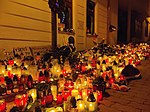Pálffy Palace (Zámocká Street)

Pálffy Palace (Slovak: Záhradné krídlo bývalého Pálffyho paláca) is a 17th-century palace of the Pálffy family on Zámocká Street in the Old Town of Bratislava, Slovakia, situated underneath the Bratislava Castle. After partial demolition at the beginning of the 20th century, only the summer pavilion of the original palace complex remains and today, the building is a protected cultural monument and is used for cultural events. Wolfgang Amadeus Mozart performed a concert in the palace during his visit of Bratislava. It is one of four historical buildings in Bratislava named Palffy Palace, the others being on Panská Street, Ventúrska Street and Hviezdoslav Square.
Excerpt from the Wikipedia article Pálffy Palace (Zámocká Street) (License: CC BY-SA 3.0, Authors, Images).Pálffy Palace (Zámocká Street)
Zámocká, Bratislava Bratislava (District of Bratislava I)
Geographical coordinates (GPS) Address External links Nearby Places Show on map
Geographical coordinates (GPS)
| Latitude | Longitude |
|---|---|
| N 48.145 ° | E 17.100833333333 ° |
Address
Pálfiho palác (Pálffyho palác)
Zámocká 2128/47
811 01 Bratislava, Bratislava (District of Bratislava I)
Region of Bratislava, Slovakia
Open on Google Maps









